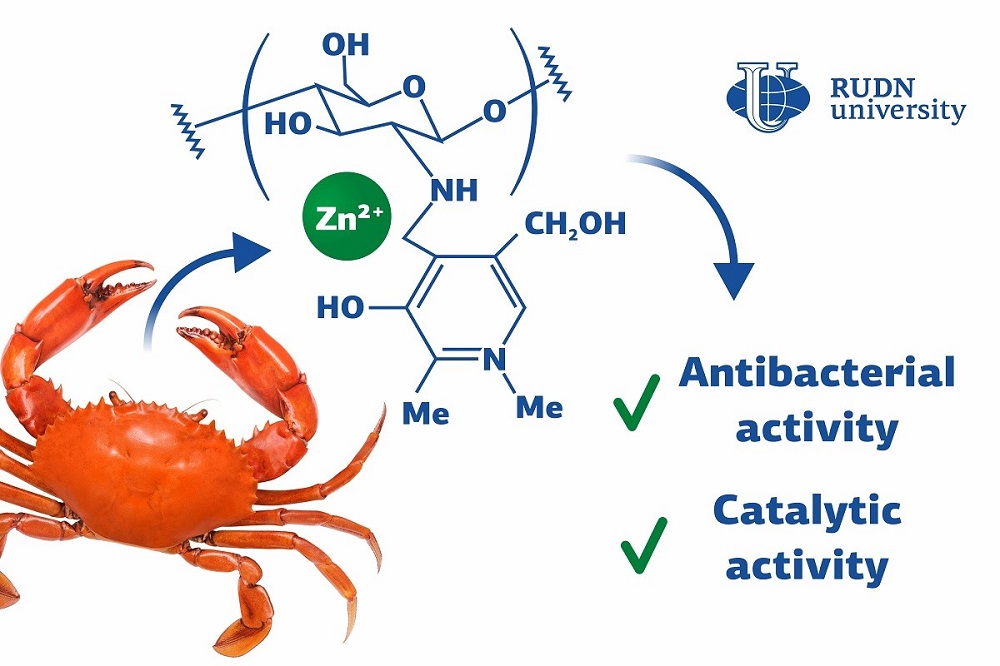RUDN chemists synthesized a chitosan multifunctional composite material

Chitosan, which is derived from chitin, the main substance in the shells of crustaceans and other arthropods, is interesting for “green chemistry” because of several properties. It is made from available raw materials, and the materials made from it are generally biocompatible, non-toxic, and easily degradable under natural conditions. In addition, they are polymers, long molecules-chains of repeating links, the modification of which allows you to give the material new properties.
“In previous studies, we were able to obtain a chitosan-based polymer with both catalytic and antibacterial properties using ultrasound treatment. It is known that the integration of metal ions into the polymer matrix makes it possible to strengthen such materials and improve their characteristics. The most suitable metal compounds for modifying our materials are complexes with divalent zinc, which also exhibits antibacterial and catalytic activity,” Andrey Kritchenkov, PhD, assistant of the RUDN Department of Inorganic Chemistry.
At the first stage of the experiment, the researchers compared the new approach to the synthesis of chitosan derivatives with the standard one. Using ultrasound allowed RUDN chemists to obtain a derivative of chitosan and iodine-containing aromatic aldehyde much faster than under conventional conditions. To 60% of the original units of chitosan joined hydrocarbon rings aldehyde, it took 10 minutes instead of three hours. In addition, ultrasound reduced the volume of aldehyde required for the reaction by 2.6 times. The reaction temperature in both cases did not exceed 25°C. The chitosan derivative was then treated with a small amount of zinc chloride and caustic soda. A composite material was formed in which each chitosan link carried an aldehyde-derived ring of atoms and a zinc cation.
For comparison, RUDN chemists synthesized a similar composite with the inclusion of zinc from pure chitosan. The catalytic effect of the new materials was evaluated in a three-component Mannich reaction, which allows simultaneously forming a new bond between carbon atoms and adding a functional group to the compound. The composite based on a chitosan derivative proved a more effective catalyst compared to both zinc-modified chitosan and inorganic zinc compounds. At the same time, the new material can be used in catalysis six times in a row due to its resistance to high temperature. In tests of antibacterial properties, the new composite was compared with the same catalytic agents as well as with the antibiotics ampicillin and gentamicin. All substances proved to be detrimental to E. coli (Escherichia coli) and Staphylococcus aureus bacteria, but the medical drugs were nevertheless two or more times more effective.
“The composite material based on a chitosan derivative with zinc showed impressive catalytic properties and antibacterial activity comparable to that of known antibiotics. To find out how these qualities are related to the structure of the material, we continue the project and synthesize similar materials in reactions with other aldehydes”, says Andrey Kritchenkov, PhD, assistant of the RUDN Department of Inorganic Chemistry.
The article was published in Aquaculture Mendeleev Communications.
RUDN summarized the results of the scientific competition "Project Start: work of the science club ". Students of the Faculty of Physics, Mathematics and Natural Sciences have created a project for a managed queuing system using a neural network to redistribute resources between 5G segments. How to increase flexibility, make the network fast and inexpensive and reach more users — tell Gebrial Ibram Esam Zekri ("Fundamental Computer Science and Information Technology", Master's degree, II course) and Ksenia Leontieva ("Applied Mathematics and Computer Science", Master's degree, I course).
The National Demographic Report, 2023 Demographic Well-Being of Russian Regions (hereinafter - the National Demographic Report) was prepared by the scientific team of the Institute of Demographic Studies of the Federal Research Center of the Russian Academy of Sciences, the Vologda Scientific Center of the Russian Academy of Sciences, Peoples' Friendship University of Russia, the Center for Family and Demography of the Academy of Sciences of the Republic of Tatarstan, as well as with the participation of leading scientists from the Republic of Bashkortostan, Stavropol Krai, Volgograd, Ivanovo, Kaliningrad, Nizhny Novgorod, Sverdlovsk Oblasts and Khanty-Mansi Autonomous Okrug–Yugra.
RUDN summarized the results of the scientific competition "Project Start: work of the science club ". Students of the Faculty of Physics, Mathematics and Natural Sciences have created a project for a managed queuing system using a neural network to redistribute resources between 5G segments. How to increase flexibility, make the network fast and inexpensive and reach more users — tell Gebrial Ibram Esam Zekri ("Fundamental Computer Science and Information Technology", Master's degree, II course) and Ksenia Leontieva ("Applied Mathematics and Computer Science", Master's degree, I course).
What is your first association with the word “laboratory”? Flasks and beakers? Microscopes and centrifuges? Yes, many of us would answer the same way.
The National Demographic Report, 2023 Demographic Well-Being of Russian Regions (hereinafter - the National Demographic Report) was prepared by the scientific team of the Institute of Demographic Studies of the Federal Research Center of the Russian Academy of Sciences, the Vologda Scientific Center of the Russian Academy of Sciences, Peoples' Friendship University of Russia, the Center for Family and Demography of the Academy of Sciences of the Republic of Tatarstan, as well as with the participation of leading scientists from the Republic of Bashkortostan, Stavropol Krai, Volgograd, Ivanovo, Kaliningrad, Nizhny Novgorod, Sverdlovsk Oblasts and Khanty-Mansi Autonomous Okrug–Yugra.